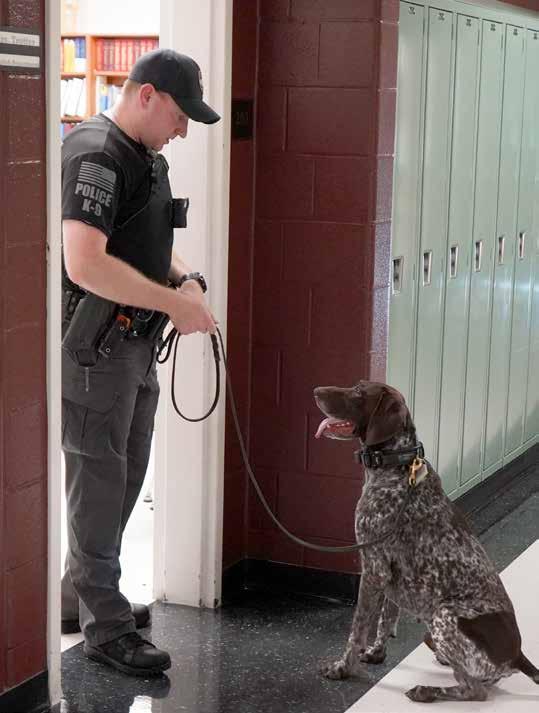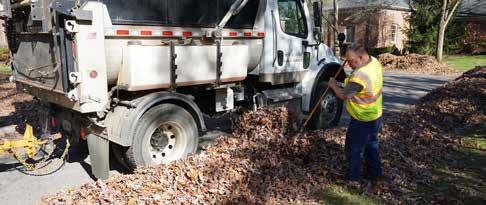
3 minute read
NAPD, Plain Township Fire, New Albany-Plain Local Schools Collaborate on School Campus Safety

Given recent school tragedies nationwide, and even guns physically being brought to the school learning campus last year, student safety is likely on many parents’ minds. New Albany Police Chief Greg Jones, a 33-year officer with the New Albany Police Department who has served as chief for the last nine years, sat down to answer questions related to safety concerns on the New Albany-Plain Local Schools campus earlier in 2022.
Talk about the partnerships the New Albany Police Department has with the New Albany-Plain Local Schools.
Chief Jones: Having two school resource officers (SROs) on campus almost every day throughout the school year has been foundational to our student safety efforts on the school learning campus, and the NAPLS school board recently voted to pay for a third SRO. Our school leaders are to be commended for staying committed to having SROs on campus at a time when some school districts didn’t. Our City Council also deserves a lot of credit for continuing to fund 100% of the costs of the original two officers on campus. With 6,000 people on campus during the school year, we look at the school campus as a small city in and of itself. Our school resource officers enhance the overall safety around the entire school campus while providing opportunities for students and staff to have positive experiences that can lead to long-lasting relationships with the officers. Something bad could still occur, but having our SROs on campus ensures that if something does happen, the NAPD response will be immediate. To that point, if there is a gunman on school campus (or a gun brought by a student to campus), can you describe what the police response would be like?
Chief Jones: The three police officers on campus would respond immediately on a moment’s notice, and they would receive back-up very quickly from other NAPD officers on duty. NAPD headquarters is less than a mile from any part of the school campus, and between that proximity and mutual aid of other agencies, the back-up response would occur very fast. And this is a critical component…it’s something we train for every year, not just as a department, but holistically with the schools and the Plain Township Fire Department, as well.
Tell us more about that training for a worst-case scenario between NAPD, the schools and Plain Township Fire.
Chief Jones: While I won’t get into any details of our planning or training, the community’s first responders partner with the schools and each other to be as ready as we can be for such a scenario. We train for a different active shooter simulation every year, not just as a department but together with fire and school staff, including teachers. The New AlbanyPlain Local School District is one of the few districts statewide that trains with an actual simulation annually. Additionally, our schools have a 172-page Emergency Operations Plan, of which the Franklin County Emergency Management & Homeland Security (FCEMHS) recently conducted a three-day audit, and FCEMHS provides bus driver training to the district. Plain Township Fire provides classroom tourniquet kits to the district and first-aid training to all New AlbanyPlain Local School staff members and they have already strategically placed citizen aid kits in select buildings and high traffic areas on campus in the event of a real threat.
What are some things residents can do to promote safety?

Chief Jones: Safety starts at home, and if guns are in a home, it is imperative that the adults keep those guns in a safe place that cannot be accessed by children. Lock boxes or locking gun cabinets are a good first step, and weapons training among the adults in the home is also very important. Parents also shouldn’t be afraid to have tough conversations with other parents to understand if guns are in the home when it comes to things like sleepovers. Finally, whether on campus or at home, our students and school staff have taken strong ownership of the “see something, say something” school policy. These are all critical components that we must take ownership of to facilitate as safe an environment as possible.

2022 Public Service Quick Facts
• Basic infrastructure maintained:
• 25,000 street trees
• 4,968 catch basins
• 2,177 sanitary sewer manholes
• 1,583 streetlights
• 1,463 fire hydrants
• 329 lane miles of roadway
• 278 miles of water, storm sewer and sanitary sewer lines


• 22 bridges
• 25 traffic signals
• Collected >1 million pounds of leaves

• Managed collection of >10 million pounds of trash, recycling and yard waste








